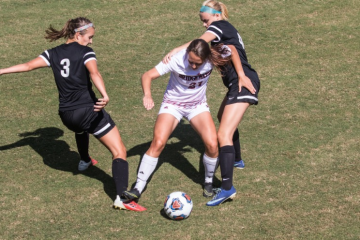USM Chancellor Robert Caret Visits Campus, Shares Insight on FSU’s Future
Days before his official inauguration as the Chancellor of the University System of Maryland, Dr. Robert Caret visited Frostburg State University’s campus to “feel its pulse” and to better learn the university’s problems, as well as its points of pride.
Caret, whose previous position was president of the University of Massachusetts, visited FSU Tuesday, November 17 through Wednesday, November 18 to meet with university officials and student leaders.
In an interview with The Bottom Line, Caret shared his impression of FSU and his goals for the university’s future.
“It’s a pleasant campus,” he said. “The new buildings have really made a huge difference, I think, in terms of the feel of the campus. The other thing I like is the life of the campus. Students were everywhere.”
“Of course, being with the students tonight [at a dinner with student leaders] and being with some of the [university administration] staff this afternoon, you get to really get a sense of what’s happening inside the walls,” he continued.
Caret’s goals for improving FSU are centered around improving student success. Compared to other institutions that focus more on research, FSU is much more student focused, he said.
“In general, you have the campuses that are more research intensive, so they will tend to, as they tour you around, for example, you meet with different people, tend to really focus heavily on a lot of the research enterprise,” he said. “What you feel in [Frostburg] is more on the teaching side, things that relate to the learning environment, success of the students, new ways to teach, things of that sort.”
Specifically, his goals relate to improving enrollment and retention rates. Increasing the graduation rate is Caret’s biggest priority, he said.
“I want to make Frostburg better,” he said. “What does that mean? Continuing what’s happening recently, expanding the enrollment. I think they had the largest freshman class in history this year. Enrollment is at an all-time high.” In 2014, FSU enrolled 1,424 freshmen, the largest freshmen class in university history.
Retaining students can be difficult, Caret said, as students sometimes can’t afford to stay at Frostburg. Caret said that a lack of jobs in the area has forced students to transfer or leave the university. FSU retains 77 percent of its students, according to university data. Retention has been trending upward since 2007, when retention was 67.4 percent
“There’s not enough jobs, for example,” he said. “The more than want to work but they can’t find a job to work, so they go some place where they can work and go to school. The way to fix that is by working with partner companies and things of that sort.”
When Caret was president at Towson University from 2003-2011, he helped develop partnerships with regional business, non-profit and civic organizations. This provided more opportunities for students to find work.
“There’s a little less opportunity for that here because it’s a more rural environment, but I do think working with the local companies” is important, he said, adding that while FSU does have some opportunities like that, more need to be developed. “I think we can do things that are more statewide to help, because there aren’t as many local opportunities out there.”
Developing programs for students to find summer internships in DC or Baltimore is one idea Caret has to create more opportunities for students.
“The other part is to work with some of the larger companies like the hospitals, or with the general community to provide funding to a community foundation to help create internships or jobs on campus itself,” he added. “Because they could hire more people on campus if they had more funding, and some of that could come from private sources.”
Building programs such as these would require funding, which poses a potential challenge. However, it’s worth noting that, as president of the University of Massachusetts, Caret struck a 50-50 deal, where half of the university system’s budget was supported by state appropriations, and half was supported by students.
“It’s gonna be a challenge, because, what’s happened here, it’s very different from Massachusetts, in that the state has actually continued to put money into the system, but because of the way the campuses are funded, it’s not distributed evenly, so you do wind up with different mixes,” he explained. “If you’re at 35 percent state support, there’s probably a campus some place that’s more like 65 percent state support. And that’s usually driven by the socioeconomics of the students themselves, so a campus that is more supported is gonna be real heavy with a student population that can afford less.”
Keeping state support at 35 percent – the current university system average – is a priority for Caret, but he hopes to increase it. “If we can get up to 50 percent, then everybody will be in better shape, he said. “That’s one of the things I don’t know if I’ll be able to do, but at least I’m going to try and push it.”
State appropriations support 34 percent of FSU budget and haven’t supported 50 percent of the budget since 1987.
“I’m going to be pretty tenacious about this college completion agenda,” he said, noting that it would save students and the university system millions of dollars. “The economic vitality piece, too, that one I think I get my hands around easier than the college completion one. That’s where I’m really going to spend time with the campuses, and do whatever I can. It’s not only the best thing to do for the student. It’s the best thing to do for everybody.”
“We’re taking in everything we’ve been learning over the last several months and the next few months and we’ll be starting to move forward.”




1 Comment